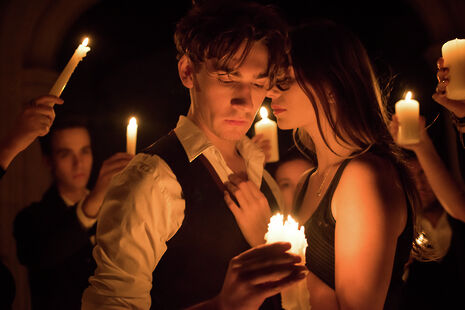Preview: The Duchess of Malfi
A revamp of John Webster’s classic tale of love and suffering

I sit off to the side of the rehearsal room, trying to make myself as invisible as possible. Zen music drifts through the sun-drenched air, and across from me two people sit cross-legged in the middle of the floor. They are holding hands, and I am immediately struck by the connection they seem to have. Every gesture and flicker of expression seems to respond instinctively to the other person, giving the impression that an entire unspoken conversation is being carried out, untranslatable by any onlooker.
Naturally my first question for Kate Marston and Joe Sefton, cast as the Duchess and Antonio in the Marlowe Society’s upcoming production of John Webster’s The Duchess of Malfi, is how being a couple in real life affects their portrayal of the famous tragic lovers. They look at each other, then at director Anastasia Bruce-Jones, and all three simultaneously burst into peals of laughter. Kate and Joe are not actually a couple, they explain, as Anastasia fist pumps the air and I feel my face redden. But their obvious chemistry promises a casting match made in heaven.
Anastasia envisions a “more naturalistic and more sympathetic” take on this classic Jacobean revenge tragedy. She tries to teach Kate and Joe to feel each other’s energy in rehearsal by asking them to lean towards and away from each other according to how drawn or repelled they think their characters feel to each other at a given point in a scene. Her attempts to foster an emotional connection between the play’s romantic leads stem from her own experience connecting with dramatic material.
“I had a real struggle doing Hamlet at one point, and there was an exercise we were doing where you felt how forwards and backwards impulses affected your character. I think that can be really helpful. Often it’s easier to feel things when we’re doing things. Physical can lead to emotional. Different people work indifferent ways. So doing as many different things as possible... going for physical, spiritual, and energetic approaches”.
Yet Kate recalls that she was initially slightly sceptical of such approaches: “It can be quite dangerous, emotional recall, because you can be quite mixed up between yourself and the character,” she remarks. “It reminds you the things the characters are feeling are real. But it allows the audience to relate to it”.
Kate has been considering carefully the delivery of the play’s most famous line, when its heroine declares “I am Duchess of Malfi still”. “I’ve been trying to say it and lay the emphasis on different words. I don’t know whether it’s the fact that she’s the Duchess or the Duchess of Malfi.” The line comes, intriguingly, at the point of the Duchess’ greatest suffering in the play, and Kate is “not sure it’s her trying to assert her authority so much as reminding her of what she is”.
Joe faces a rather different challenge, as he finds that he often has to navigate the conspicuous silences of Antonio and their contrast to the voluble Duchess. Part of the complication comes from the vast class separation between the characters. “It’s working out what he can and cannot say, and what’s wise to say,” Joe explains. “I think particularly in the proposal scene. He’s constantly reminded of who he is, so I think it’s partly like the speech where he says he loves listening to her talk. And I can imagine his mind wandering quite a lot and then zoning back into what she’s saying. I think when you’ve got this character that you’re playing opposite, it’s written so beautifully that I understand why he doesn’t say anything”.
Anastasia remarks too that she has made significant changes to the drama’s primary villain, the Duchess’ twin brother Ferdinand. Webster’s text, she explains, often makes it very easy to stereotype Ferdinand, whereas this production will offer a new interpretation, attempting to push against the original play’s “insensitivity to mental illness”.
The Duchess of Malfi is on from Tuesday 8th to Saturday 12th November at the ADC
 Features / 3am in Cambridge25 June 2025
Features / 3am in Cambridge25 June 2025 Comment / Why shouldn’t we share our libraries with A-level students?25 June 2025
Comment / Why shouldn’t we share our libraries with A-level students?25 June 2025 Theatre / Twelfth Night almost achieves greatness26 June 2025
Theatre / Twelfth Night almost achieves greatness26 June 2025 News / Gardies faces dissolution27 June 2025
News / Gardies faces dissolution27 June 2025 Sport / Sport, spectacle, and sanctioned collisions: May Bumps 202525 June 2025
Sport / Sport, spectacle, and sanctioned collisions: May Bumps 202525 June 2025



